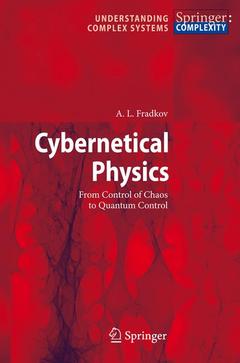Cybernetical Physics, Softcover reprint of hardcover 1st ed. 2007 From Control of Chaos to Quantum Control Understanding Complex Systems Series
Langue : Anglais
Auteur : Fradkov A.

In this book a number of ideas and results related to the ?eld of cybern- ical physics ? the scienti?c area aimed at the study of physical systems by cybernetical means ? are presented. Although some publications in physical journals related to control problems appeared long ago, formation of a se- rateself-sustainedareastartedaslateasinthe1990sduetotheexplosion-like developmentofresearchincontrolofchaos,quantumcontrol,andotherareas. The number of publications has reached several thousands by the end of the century and it continues to grow very rapidly. This book is, perhaps, the ?rst attempt to present a uni?ed exposition of the subject and methodology of cybernetical physics as well as solutions to some of its problems. A part of this book presents the limits of system transformation by means of control both for conservative and for dissipative systems based on Hamiltonian description of system dynamics. A survey of various control applications in physics is given: control of chaos, controlled synchronization, control of spatiotemporal systems, control ofmolecularandquantumsystems.Anapproachforbuildingmodelsofsystem dynamics based on control methods is discussed. The presented methods and results are illustrated by examples of new approaches to classical problems: Stephenson?Kapitsa pendulum, escape from a potential well, synchronization of coupled oscillators, control of chemical reaction with phase transition, c- trolled dissociation of molecules, controlled oscillations of complex crystalline lattices. Controlled pendulums appear in many parts of the book since p- dulum models can be thought of as the ?atoms of nonlinear physics?.
Introduction: Physics and Cybernetics.- Subject and Methodology of Cybernetical Physics.- Control of Conservative Systems.- Control of Dissipative Systems.- Controlled Synchronization.- Control of Chaos.- Control of Interconnected and Distributed Systems.- Control of Molecular and Quantum Systems.- Control Algorithms and Dynamics of Physical Systems.- Examples.- Conclusions: Looking into the Future.
From the reviews:"This book belongs to a interdisciplinary area which is infinitely broad and reflects the increase of information exchange and dissemination of ideas between experts from different backgrounds and research areas. The contents of this book is really wide. ... This book is a part of Springer complexity program and may be very useful for researchers from different backgrounds in physics, mathematics, engineering and postgraduate students working for a deeper understanding of structure and behavior of complex systems." (Yuri N. Sankin, Zentralblatt MATH, Vol. 1117 (19), 2007)"This book is an attempt to present a unified exposition of the subject and methodology of cybernetical physics as well as solutions to some of its problems. ... has been written for researchers with diverse backgrounds in physics, mathematics, and engineering, and this makes it suitable for graduate students as an introduction to a broad range of complex systems in the natural sciences. The book has eleven chapters and seventy figures." (Vimal Singh, Mathematical Reviews, Issue 2008 j)
Date de parution : 11-2010
Ouvrage de 236 p.
15.5x23.5 cm
Date de parution : 01-2007
Ouvrage de 236 p.
15.5x23.5 cm
© 2024 LAVOISIER S.A.S.



